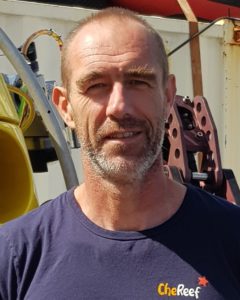The abyssal plains, which lie at a depth of about 5,000 metres, are extreme environments where no light penetrates. The water temperature is about 2°C and the pressure is high. Contrary to all expectations, a great diversity of species can be found there. However, many of them have only a small number of individuals because food is scarce: only 1% of the organic matter produced on the surface reaches the deep sea. Fish, crustaceans, sea cucumbers, starfish, sea urchins and marine worms live there. How can this great diversity be explained? This remains a mystery today.
Some environments are real oases in the deep sea: canyons, seamounts, and hydrothermal springs. Around the latter, conditions are very different. The water is hot (several hundred degrees) and acidic, very poor in oxygen and rich in methane and hydrogen sulphide (H2S). These compounds are oxidised by bacteria which produce energy and organic matter consumed by the fauna. The fauna is very abundant in terms of species and number of individuals. Giant mussels (Bathymodiolus sp.), giant tube worms (Riftia pachyptila), hairy gastropods (Alviniconcha sp.) and swarms of shrimps (Rimicaris sp.) can be found.
How long have these hostile environments been explored?
It goes back to the first manned submarine dives. Ifremer launched the Cyana in 1969, and the hydrothermal springs were discovered in 1977. But it was the Nautile in 1984 that made the greatest advances thanks to its ability to descend to 6 000 metres. Manned submarines are still essential to observe unknown sites with the naked eye.
New unmanned craft complete the arsenal. ROVs, the first of which date back to the 2000s, are remote-controlled underwater drones linked by a cable to the ship. Other fully autonomous drones, the AUVs, are now being used. Since 2020, France has had one of the four AUVs in the world capable of diving to a depth of 6,000 metres 1. These drones can film and map large areas of the sea. Ifremer’s next step is to add a larval collection system to them, as the larval life cycle is one of the missing elements in our understanding of the life cycle of deep-sea organisms.
Deep-sea biodiversity: a range of economic resources
Deep-sea organisms, particularly those from hydrothermal springs, are adapted to hostile living conditions: high pressure, high temperature, acidic environment, presence of toxic molecules (H2S), etc. Their components are of interest to many industries using biotechnologies, such as chemistry, pharmaceuticals, and food processing. Their components are of interest to many industries using biotechnologies, such as chemicals, pharmaceuticals, and food processing. For example, some annelids (worms) contain molecules with interesting antibiotic properties 2. Another potential spin-off is that some bacteria have the potential to produce hydrogen by fermentation, a major asset in the energy transition.
Do new instruments help to advance our knowledge?
Yes, for the past ten years or so we have been taking advantage of the numerous data collected by the seabed observatories. These are real observation stations permanently installed on the ocean floor. There are two types: autonomous observatories, which are battery-powered and require annual maintenance to recover the data; and cabled observatories, which are very expensive and transmit their data in real time. Observatories installed near hydrothermal springs – such as on the eastern Pacific rim or in the Azores 3 – continuously film the fauna and measure various environmental parameters.
They represent a real advance: unlike campaigns at sea, they offer continuous measurements that provide information on the dynamics of ecosystems. Against all expectations, they have revealed the great stability of the Azores hydrothermal mussel field over a decade. The influence of the tide on deep-sea ecosystems was also described thanks to these observations.

And what about environmental DNA – a technique for identifying species from DNA traces left in the water – which seems to be increasingly used in aquatic environments?
Environmental DNA was first used in the deep sea a few years ago, as part of the Pourquoi pas les abysses? (“why not the abysses?”) project led by Ifremer 4. The aim of this project is to carry out an inventory of deep-sea biodiversity. The number of species reported by this technique is phenomenal compared to observations alone. But the deep sea is a cold environment in which DNA can be preserved for a long time: did these organisms really live there, or are these samples the trace of a fragment that drifted there? We don’t know.
The other limitation of environmental DNA is that the DNA detected must be linked to a species whose morphology has already been identified. However, very few species are known: the objective of the international Barcode of Life project 5 is to increase the size of this database. Today, 90% of the species in each sample from the abyssal plains are unknown.
If the biodiversity of the deep sea is so poorly known, how can the impact of mining be assessed?
They are indeed poorly known. The uncertainties concern first and foremost the extent of the impact. The plume of sediment generated by mining will disperse in the water column and then fall to the bottom. This dispersion is difficult to assess. Moreover, as mentioned above, the abyssal plains are inhabited by many rare species – with very few individuals – and whose larval cycle is not well known. It is impossible to know their recolonisation capacity, nor their role in each ecosystem. The risk of extinction cannot be ruled out.
A first pilot exploitation test has been carried out by the Belgian company Global Sea Mineral Resources in the Clarion-Clipperton zone, prized for its polymetallic nodules. The environmental impact is being assessed as part of the MiningImpact research project 6. But we are still far from being able to assess the long-term impact of mining over several thousand square kilometres.
It must be recognised that the fauna we are talking about represents a very small biomass. Its disturbance would not really have any consequences on the major biogeochemical cycles, such as that of carbon. The carbon arriving at the bottom would still be degraded by bacteria, which we know will not be durably impacted by exploitation. The question that must be asked is: does biodiversity have an intrinsic value?







